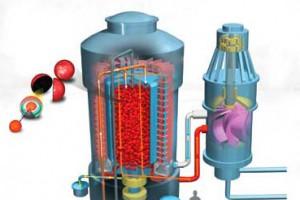Using the power of a vacuum pump.
The milling machine work table itself is a horizontal surface that is designed for working with the part (it is fixed and securely based on it). This part of a milling machine is considered one of the most important - if the workpiece is not securely and evenly fixed relative to the movement of the cutter, then accurate and efficient processing will become unrealistic. Both the table and the cutting tool can move.
Milling machine work table with numerical control software It is equipped with longitudinal grooves where a number of clamps are placed to secure the part for processing or other necessary devices. But fastening with clamps has several disadvantages:
There must be mechanical clamping of the workpiece; the tightening force is set to the maximum.
Deformation and mechanical damage the front part of the manufactured part. Such consequences are absolutely undesirable for working with glass boxes equipped with backlighting - even the most minor scratches and cracks can completely ruin the appearance.
If the workpiece has some non-standard dimensions and shapes, then it is not always possible to select the required location due to the lack of symmetrical holes.
Difficulty with placement soft materials, which can bend when touched by a cutter (these are composite models with rather large dimensions). There is no way to install a large number of clamps on a table, so working with these types of workpieces is very difficult.
All of the above inconveniences can be solved quite simply - just install a vacuum table. It helps to securely fix the workpiece in the required place for precise machining with a milling cutter, without using mechanical clamps. The very essence of the work is that the air is pumped out, thereby reducing the pressure between the work table and the surface of the workpiece. This creates a kind of “suction cup” that firmly presses the part using atmospheric pressure. This helps to firmly and reliably fix the workpiece in the required position.
However, the vacuum table also has disadvantages:
– the impossibility of attaching very small parts or parts that are not sheet materials.
Usually, all manufacturers, when equipping a machine with a vacuum table, also leave the possibility of fastening with clamps, however, they are much smaller and they are no longer located as often as in a regular table.
– The compressor that maintains the vacuum requires a fairly powerful 5 kW, which usually leads to an almost doubling of energy consumption by the milling machine.
Therefore, every manufacturer must very carefully consider the pros and cons of vacuum fastening and make the choice himself.
Varieties vacuum tables
Vacuum tables are divided into several types depending on the type of workpiece fastening:
Lattice. This type is most common, since it is easier to install and the cost is affordable. Thanks to its unique lattice design, it allows you to place required amount insulating material to enclose the workpiece around its perimeter. The pump pumps out air from the resulting circuit, thereby reliably pressing the part to the surface of the work table.
Vacuum tables VAC-MAT type. They are a rigid, durable frame made of polymer. It divides the space between the workpiece and the compactor into a number of sectors isolated from each other, from which air is then simultaneously pumped out. Thus, the vacuum is maintained even with the through type of milling; the compartments cannot be depressurized.
Slotted variety. They are indispensable when working with small workpieces, or with those parts on the surface of which there are many holes. Such a table is equipped with a number of grooves and compartments, some of which can be combined (if the holes match those on the workpiece).
Porous boards. They are recommended to be used for working with very thin material (like sheets of foil, for example). It can accurately reproduce the outline of the workpiece, the degree of impact depends on the area the “substrate” occupies. This vacuum material allows you to achieve high precision in processing and avoid errors. It is not permissible to work together with the coolant system.
Board type FLIP-POD. This a large number of separate suction cups-valves, which are designed for reliable fastening of even fairly massive workpieces. This system of vacuum tables does not involve covering the perimeter of the workpiece with a compactor, which makes it possible to process cutting tool edges of the part.
Almost all manufacturers of milling machines with numerical control offer the option of equipping their products with a special vacuum table. It is installed quite simply; there is no need to carry out any special operations or reconfigure the equipment - you just need to connect the compressor or vacuum pump.
Systematic Automation has been manufacturing vacuum tables for over 30 years.
Practically perfect surface(tolerance no worse than ± 25 microns / sq. ft.) - the result of a unique manufacturing technology and the use of high-quality equipment. Annually
Systematic Automation manufactures thousands of vacuum tables annually for a variety of unique applications: assembly manufacturing, CNC machining, forming, cutting, digital printers, photography, engraving, fabric processing, inkjet printers, research equipment, laboratory equipment, laminating, laser engraving and cutting, plotters, sail making, screen printing, ultrasonic cutting machines, presses, carpet cleaning.
Design of vacuum tables
The top of the table is made of durable aluminum alloy 3mm thick. Usage epoxy resin in design, provides good protection from dents and bends.
The base of the vacuum table has a “honeycomb” structure and is made of a material that reduces the effect of temperature differences on the unevenness of the table surface. The honeycomb design ensures uniform air flow across the entire surface of the table.
The “collector” measuring 25x25mm is located around the honeycomb base, due to which the best possible distribution of vacuum is achieved between all the holes in the table.
Hole size
In the standard version, the holes in the table have a diameter of 1.6mm, and are located in 12.5mm increments, which is optimal for most jobs.
Materials such as 127µm thick polycarbonate or vinyl will not deform against 1.58mm holes under the full force of a standard vacuum pump (see specifications).
Optionally, the holes can be custom-sized (minimum 0.79mm). The 0.79 mm holes are countersunk on the underside for minimal losses air flows.
Fastening
All tables have a 9.5mm flange around the perimeter for mounting. If the fitting for connecting the vacuum pump is located not at the bottom, but at the side, then there will be no flange on this side. If necessary, mounting holes will be drilled in the flange in accordance with the customer's drawing.
Standard parameters Options FAQ Video
External dimensions of standard vacuum tables. Vacuum holes are located 25mm from the edge.
- 127x152x30mm. (5″ x 6″ x 1 3/16″)
- 203x203x30mm. (8″ x 8″ x 1 3/16″)
- 304x203x30mm. (12″ x 8″ x 1 3/16″)
- 304x304x30mm. (12″ x 12″ x 1 3/16″)
- 304x406x30mm. (12″ x 16″ x 1 3/16″)
- 304x609x30mm. (12″ x 24″ x 1 3/16″)
- 304x762x30mm. (12″ x 30″ x 1 3/16″)
- 355x355x30mm. (14″ x 14″ x 1 3/16″)
- 406x279x30mm. (16″ x 11″ x 1 3/16″)
- 457x279x30mm. (18″ x 11″ x 1 3/16″)
- 508x406x30mm. (20″ x 16″ x 1 3/16″)
- 508x431x30mm. (20″ x 17″ x 1 3/16″)
- 508x457x30mm. (20″ x 18″ x 1 3/16″)
- 508x508x30mm. (20″ x 20″ x 1 3/16″)
- 558x558x30mm. (22″ x 22″ x 1 3/16″)
- 609x457x30mm. (24″ x 18″ x 1 3/16″)
- 609x558x30mm. (24″ x 22″ x 1 3/16″)
- 609x711x30mm. (24″ x 28″ x 1 3/16″)
- 660x355x30mm. (26″ x 14″ x 1 3/16″)
- 660x482x30mm. (26″ x 19″ x 1 3/16″)
- 660x508x30mm. (26″ x 20″ x 1 3/16″)
- 660x762x30mm. (26″ x 30″ x 1 3/16″)
- 660x863x30mm. (26″ x 34″ x 1 3/16″)
- 685x1016x30mm. (27″ x 40″ x 1 3/16″)
- 711x812x30mm. (28″ x 32″ x 1 3/16″)
- 762x508x30mm. (30″ x 20″ x 1 3/16″)
- 762x863x30mm. (30″ x 34″ x 1 3/16″)
- 762x1016x30mm. (30″ x 40″ x 1 3/16″)
- 914x914x30mm. (36″ x 36″ x 1 3/16″)
- 1219x1219x30mm. (48″ x 48″ x 1 3/16″)
- 1219x2438x38mm. (48″ x 96″ x 1.50″)
- 1828x3657x38mm. (72″ x 144″ x 1.50″)
- Tables available in custom sizes. Please check.
- Vacuum pump
- Vacuum valve
- Vacuum table air supply valve
- Pressure force regulator.
- Pedal
- Stops for positioning products on a vacuum table.
- Extendable vacuum tables
- Plastic (Formica) table top
- Independent vacuum zones controlled by valves.
- Anodized table surface
- The location of the vacuum holes according to the customer's drawing
- Table shape and size according to customer requirements
Q: How can I secure the vacuum table?
A: The table has a 9.5mm bottom and top flange around the perimeter. You can use them for clamps or drill holes for fastening.
Q: Is it possible to use threaded connection for vacuum liner?
Oh yeah. Please indicate the required size.
Q: I already have a vacuum pump. Will it work with your vacuum table?
A: Most likely it will work. In any case, you can order the pump later. If you decide to use your own pump, you can immediately order an adapter/adapter. When ordering, please indicate dimensions.
Q: I work with materials that can be scratched. Is it possible to avoid them when working on a vacuum table?
A: Yes, you can use the switch valve to blow air out of the table. This will have the effect air cushion. Optionally, you can adjust the amount of incoming air. To operate the valve, compressed air is required at a pressure of min. 4.2 bar.
Q: How flat is the surface of the vacuum table?
A: Tolerance no worse than ± 25µm/sq.ft.
Q: How should I secure the table to prevent bending?
A: As a rule, the lower part (surface) of the table is flat and parallel to the upper part, therefore, the table can be mounted on the base of the machine.
When installing the table on a surface, pay attention to the absence of gaps that indicate unevenness of the surface. Use shims to eliminate table wobble due to gaps. Check parallelism. If necessary, use additional spacers to eliminate the possibility of the table bending under pressure and disturbing the plane of the working surface of the vacuum table.
Q: Is there a way to place items on the table in exactly the same place?
A: Yes, it is possible. An optional stop system for product positioning can be ordered. As a rule, these are three steel pins that are “pushed out” from the table while the product is being placed and “recessed” into the table as soon as the vacuum is turned on. It is possible to place more than three pins.
Find out the price!
The manufacturer reserves the right to make changes to the design and specification of screen printing equipment without notice.
With large parts, a large vacuum table is required. Such equipment is very expensive due to the complexity of transportation and is not always suitable for certain tasks, but you can design the table yourself, under custom size and needs.
Vacuum tables for CNC are designed for milling machines that work with large sheets of wood or metal. Most CNC machines use curved machining. To work on milling machines, you need a surface that reliably holds the workpieces. The vacuum table presses the products to the surface, preventing them from moving, making work on the milling machine more accurate and comfortable. In addition, complete equipment provides heating to the required temperature. It is more versatile than a magnetic table, which is only suitable for processing metal products.
Quite often, CNC milling machines come complete with a vacuum table, but if it is absent or is not large enough, another device is required. In this case, you can buy a used device of questionable quality or make it yourself.
Required materials and tools
To make a vacuum table for a milling machine, you need to find all the components. To create functional equipment you will need:
- wooden or metal sheet of appropriate size;
- metal profile;
- Vacuum pump;
- a heating element;
- Control block.
Tools you will need: drill, screwdriver, spanners, soldering iron. The remaining tools are used optionally, if available.
Manufacturing stages
After purchasing all necessary materials and tools, you can go to self-assembly table.
Manufacturing of working surface and box
At the beginning of making a vacuum table for CNC with your own hands, you need to create work surface. To do this, take a pre-prepared sheet of material. Holes are carefully drilled in it, in a checkerboard pattern, using a drill or screwdriver. Later, from the back, the surface will be adjacent to the vacuum pump, which serves to securely fasten the products. To increase the reliability of the structure, partitions are installed. They prevent the table from deforming during use.
Box
The most significant thing here is the height, since the table is designed for a numerically controlled machine. A stable structure is assembled from metal and wooden parts to secure the working surface. The surface above the working area will act as a holder for the heating element. It is desirable that the box be collapsible: this will facilitate further work, setting up equipment or transporting the table in the future.
The desktop should be as stable and reliable as possible. Therefore, it is advisable to avoid short-lived or moving connections in the design. To make it easier to move the tool, you can use adjustable height feet. This will allow you to work without flat surface, providing stability.
A heating element
Vacuum forming of plastic also requires a special table. During operation, the product is exposed to a vacuum field and a heating element, which heats the plastic to the required temperature. To do this, a heating panel is installed above the table. Nichrome thread has proven itself best as a heating element. However, due to the high cost of the material, as well as the difficulty of finding it for free sale when self-production Usually halogen lamps are used.
Among the advantages of use should be noted uniform heating, as well as quality lighting work area.
A sheet of metal is taken as a workpiece. Holes for lamps are also drilled in it, after which the heating elements are secured and the electrical part is installed. All lamps must be connected in parallel. With more complex design the electrical part is output to the controller or separate switches to heat certain parts working area. The connection is made using soldering and copper wires. To reduce wiring, have a more pleasing appearance, ease of operation and greater wiring reliability, it is recommended to use a printed circuit board or several small circuit boards. The design of the light panel should also be dismountable for maintenance.

Vacuum pump
The most important piece of equipment. Serves to create a vacuum and securely fix the part. It is best to use a specialized vacuum generator with a pressure gauge. If a dedicated vacuum pump is not available, several vacuum fans will do. It is possible to replace them with industrial vacuum cleaners, but in practice their efficiency is lower.
When connecting, it is important to reduce the air flow as much as possible, that is, insulate from the entrance to the working surface. A pressure gauge is needed to measure the results: too much vacuum can damage the part, work surface or equipment. With a more complex table design, the heating part regulators and pressure gauge are installed in the control unit.
Control block
The electronic part of the vacuum table is needed to effectively regulate the heating of the working area and create a more stable fixation of parts. There are many options for implementing a control unit; the biggest role here is played by milling machine and numerical control installed in the working equipment. The most optimal one is selected based on the tasks, budget, and availability of specific elements. For optimal performance A microcontroller with a display and one relay for each control unit are required.
For comfortable work Temperature and pressure sensors are used. With the minimum configuration, one sensor and 2 relays are required: one for turning the pump on/off, the other for control heating panel. To delimit the work area, use the clamp and heat only for part of the table, it is necessary to use a larger number of relays and, accordingly, a more powerful controller. Installing a reliable control unit will make work more comfortable and will allow you not to be distracted by pressure gauge readings.
Good day brain artisans! Our team somehow needed a table vacuum forming to create a variety of homemade, but there was no large-sized table on sale. Without thinking twice we made it with your own hands!
Step 1: Desk Box





A vacuum table is essentially a hollow box with many small holes through which air is pumped out of the workspace. We chose MDF to create this box, but any durable one will do. sheet material. So, we create a table box from MDF and drill small holes in the front panel, either on a machine, or we can use a regular one brain drill.
We attach the legs to the box and install partitions with large holes, about 7.5 cm. These partitions will keep the table flat and will not allow it to sag.
Step 2: Heat Source




Initially we planned to use nichrome wire as a heater, but it is quite expensive and difficult to obtain. Therefore, we settled on GU10 halogen lamps, which provide little light, but provide enough heat.
IN metal sheet We drill holes for ceramic lamp sockets and install these sockets. Next, for ease of installation of the circuit, in order to reduce the amount of soldering, we create from printed circuit boards conductive tracks, install them, and then solder the tracks into a circuit. For this panel with MDF lamps we make a box with a removable brain cap for maintenance, and accordingly we place the light panel in this box.
Step 3: Management



The heat source option we have chosen allows us to heat not only the entire table, but also, if necessary, only some of its sections when molding small crafts. Of course, connecting the lamps becomes more complicated.
The table control unit consists of several elements:
- The front panel contains an alphanumeric LCD display, LED indication of each heating row, a table power key, an emergency stop button for the table, and table operating mode switches.
- ATmega644 microcontroller board, which works with firmware written in C. A temperature sensor in the table, a pressure sensor, an LCD display, mode switches from the front panel, as well as a relay for controlling the power of the heaters (lines of light bulbs) are connected to this board.
- Controller board alternating current, which synchronizes the signal from the microcontroller, the triac and the AC line.
- A relay board, which consists of 6 electromechanical relays controlled by a microcontroller. One of the relays turns on the fan, and the rest turn on the heater lines.
- Neutral relay board, which consists of 7 relays controlled by a microcontroller and connecting the heater lines to the neutral wire, as well as a temperature sensor in the table space.
- A triac consisting of two opto-isolated thyristor solid-state relays, rated at 20A, 240V, which regulates the fan and heating of the table space.
Step 4: Installing Supports



On our table box crafts, and by the way it is 600x900mm in size, we mount the supports for the heater panel and install the panel itself with the lamps. We also make a frame for the plastic and insert it into the supports on bearings; we seal the junction of the table box and the frame with insulating porous tape.
Step 5: Vacuum Fan


To the bottom side of the box brain table We attach a vacuum source, simply a fan. For our vacuum fan, we made an additional plate from MDF and with its help, as well as with the help of neoprene gaskets, we installed it.
Step 6: Final Assembly and Testing

On final stage We connect all the elements, check that everything is installed correctly and proceed to testing. We insert a sheet of plastic for molding into the frame, turn on the table and mold!



Here's how our table works:
Successful homemade and I hope our guide will help you with this!
Making a vacuum table is the most critical stage in constructing a thermal vacuum press with your own hands. At the design stage, it is necessary to determine the dimensions of the table, select the material for its manufacture, and think over ways to fix and seal detachable elements to maintain internal negative pressure (vacuum). The vacuum table is made with the same basic set of tools as.
Further in the text, we will call a vacuum bath a part of a vacuum table - a steel container, inside of which the workpieces to be coated are located, and from which air is pumped out. By working dimensions (dimensions) of a vacuum bath we mean its useful volume, measured by internal dimensions. We will agree to call the vacuum table the entire structure as a whole, consisting of a vacuum bath, an upper (movable) pressure frame, clamps and other smaller elements.

External and working dimensions of the vacuum bath.
Let's consider general principles choosing the size of the vacuum bath, we will designate specific numbers for our press.
The longer the vacuum bath, the more workpieces can be placed in it, or the workpiece can be lined bigger size. On the other hand, the longer the bath, the more film has to be consumed in one working cycle, the larger the dimensions of the machine, which entails a greater consumption of room space. Need to find optimal size. As experience has shown, the optimal working length of a vacuum bath intended for the manufacture of standard furniture facades and decorative door trims, we can consider the value to be from 2.4 to 2.6 m. We will make a vacuum bath 2500 mm long, the working length of which will be 2500 - 40 x 2 = 2420 mm (40 mm is the width of the short wall profile pipe).
The width of the bath is directly related to the width of the PVC film used. Depending on the film manufacturer, there may be different widths; the most common is 1.4 m, which is what we will focus on. Let's choose the width of the bathtub to be 1400 mm, the working width will be 1400 - 40 x 2 = 1320 mm. When facing tall workpieces, for example, for curved (radius) facades, the width of the bathtub must be reduced (made smaller than the width of the film), but to work with such workpieces a press of a different design is needed, so these issues will not be considered.
The working height of the bathtub should be calculated based on the requirement that there is a small free space between the upper surface of the facades and the covering film. In other words, the film stretched over the workpieces should not touch them before air is pumped out. The calculation is as follows. Firstly, the vacuum (breathable) tabletop, which will be the first to be placed on the vacuum table, will be made of 10 mm thick MDF board. Secondly, the linings for the facade blanks will be small pieces of MDF board 16 mm thick (this is the simplest, most common and best option linings). Thirdly, the thickness of the veneered blanks will range from 8-10 mm (door linings) to 16-32 mm (facades and other furniture elements). Fourthly, the sealing rubber will add about 2 mm to the depth of the bath. As a result, the maximum height of the entire “pie” inside the bathtub will be: 10 + 16 + 32 = 58 mm. To make a vacuum bath, we will use a profile pipe with a cross-section of 60x40 mm, placing it on the short side. At the same time, the height of the free space will be no less than: 60 + 2 - 58 = 4 mm, which is quite enough.

Making a vacuum table.
Vacuum bath.
The bottom of the vacuum bath will be a sheet of steel 2 mm thick. To minimize the deflection of the sheet under the influence of negative internal pressure, and to give the table surface an even shape (close to an ideal plane), it is necessary to make a rigid frame. To make the frame we will use the same profile pipe 60x40x2. The pre-cut pipe, in accordance with the design, is laid on the slipway, rigidly fixed with clamps, and all connections are welded. After making the stiffening frame, a steel sheet is welded on top of it. This is the most critical stage welding work, it requires a continuous weld to be hermetically sealed (double penetration is recommended).
To avoid warping of the sheet under the influence of prolonged high temperatures, you can use the following alternative method of welding the sheet to the stiffener frame. Before laying the steel sheet on the stiffening frame, it is necessary to apply a sealing compound around its perimeter that can withstand high temperatures(for example, silicone high-temperature sealant), and welding is carried out not with a continuous seam, but with small regular fixing tacks with a pitch of about 50 mm. This method is designed to ensure that short-term, local welding effects will not damage (burn out) the entire sealant, but only a small part of it in the immediate vicinity of the tacks, while most of the sealant, after curing, will perform its direct function.



Vacuum table dimensions.


Detailing of the stiffening frame and the procedure for assembling the vacuum bath: the stiffening frame is welded, a steel sheet is welded to it, a stationary (lower) frame with a part of the hinge joint for attaching the lifting (upper) frame is hermetically welded around the perimeter of the steel sheet.

Photo of the vacuum table from below.
The stiffening frame is made partly from an angle profile.
Lifting (pressing,top)frame.
Frame material - profile pipe 60x40x2 mm. The dimensions of the pressure frame must be exactly the same as those of the vacuum bath. If it was not possible to find a sufficiently even (not bent, not twisted) profile, then it is necessary to pre-select in pairs several of the smoothest rods from which the parts of the vacuum table will be made tightly adjacent to each other.
The clamp frame will rise thanks to adjustable hinge joints. The adjustment of the hinges is carried out after gluing the seal - strips of sheet rubber of medium hardness, about 2 mm thick.



Welded washers are needed to increase the friction area. The hinge pin is a D12 steel rod with threaded ends.


To hold the clamping frame in a raised state, gas lifts can be used. For safety reasons, it is recommended to install four gas lifts (two per side) and ensure that any three of them can support the frame. If the opening angle of the frame (45°) turns out to be insufficient, the frame will cause significant inconvenience in operation; it can be raised as high as possible at an angle of slightly more than 90°, using the thermal module parked behind as a support (gas lifts are not used).

Clamps.
To securely and tightly hold the film during vacuum pressing, it is necessary to firmly and evenly press the upper frame to the perimeter of the vacuum bath, ensuring that the rubber seal fits everywhere. For these purposes, you can use various ready-made clamps, or make them yourself.
For the manufacture of homemade clamps working on the eccentric principle, you will need the following rolled steel: half a meter of DN50 pipe (external diameter about 60 mm), two meters of rod with a diameter of 10 mm, and approximately the same amount of profile pipe with a cross-section of 20x20x2 mm.
Firstly, the DN50 pipe is cut into 8 equal 60 mm sections. Each pipe section is finished with a semicircular central cutout having a width of 10-11 mm and an arc length equal to 3/4 of the length of the outer circumference of the pipe. We get 8 pieces of eccentric rotary cylinders, to which we need to weld a handle 220 mm long from a square profile 20x20 mm.
Secondly, the steel rod is cut into 16 pieces: 8 pieces 190 mm long (for studs) and 8 pieces 55 mm long (for kingpins). An M12 nut (or M10 with a drilled thread) must be welded to one end of the stud so that it can rotate freely on the pivot, and an M10x50 thread must be cut at the other end.
Thirdly, to complete the manufacture of the clamp, we weld the ends of the pin (with a nut with a welded pin pre-attached to it) to inner surface eccentric rotary cylinders.
To install clamps on the vacuum table of the press, at eight points of the table, according to the project, drill through holes with a diameter of 10 mm. After which, the upper holes are enlarged, giving them an oblong shape. The clamps are adjusted by installing combination nuts in the desired location on the stud thread, followed by fixing them with locknuts. This operation is performed on last stage manufacturing a vacuum table, after gluing the rubber seal.



Elements and dimensions of the hinge clamp.





The hooks for the clamps are made from 50x50x3 angle steel.
If it was not possible to achieve a flat table surface.
If during the welding process the sheet has undergone significant deformations that go beyond the permissible values, then there is no need to pick up a grinder and cut off the welds and redo everything again. You can ensure a perfectly flat plane of the vacuum table additional measures, namely through the use of epoxy leveling compounds, which are used in the manufacture of poured floors. To do this, the vacuum table is set strictly according to the level, the required volume of the filling mass is determined (for example, by test filling with water), the bottom of the vacuum bath is cleaned of rust, and it is primed. Fill with the prepared epoxy mixture according to the manufacturer's instructions. For reasons of economy, the mixture can be diluted with some cheap filler, for example, quartz sand. To speed up the curing of the mixture after pouring, the table can be controlled from above with heat from the thermal module. It makes sense to carry out this filling leveling operation after the vacuum press is fully ready, test samples of products have been manufactured, and a decision has been made about the need to improve the geometry of the working surface.
Estimate for material for a vacuum table.
| Name | Length, mm | Quantity, pcs. | Purpose |
|---|---|---|---|
| Profile 60x40 | 2500 | 6 | Rigidity frame. Bath. Lifting frame. |
| Profile 60x40 | 1380 | 4 | Rigidity frame. |
| Profile 60x40 | 1320 | 4 | Bath. Lifting frame. |
| Profile 60x40 | 1001 | 6 | Rigidity frame (diagonals). |
| Profile 60x40 | 753 | 3 | Rigidity frame. |
| Profile 60x40 | 250 | 4 | Hinge. |
| Profile 60x40 | 180 | 2 | Hinge. |
| Profile 60x40 | 150 | 2 | Clamp support. |
| Profile 60x40 | 140 | 2 | Hinge. |
| Corner 50x50x3 | 50 | 8 | Lifting frame (clamp hook). |
| Profile 20x20 | 220 | 8 | Clamp |
| Pipe DN50 | 60 | 8 | Clamp |
| Rod D10 | 190 | 8 | Clamp |
| Rod D10 | 55 | 8 | Clamp |
| Rod D12 | 150 | 2 | Hinge. |
| Nut M10 combi | 8 | Clamp | |
| Nut M10 | 12 | Clamp Table mount. | |
| Nut M12 | 16 | Clamp Hinge. | |
| Washer d12 | 12 | Hinge. | |
| Bolt M10x60 | 4 | Table mount. | |
| Sheet 2500x1500x2 | 1 | Table (bottom of the bath). | |
| Gas elevator | 2 | Lifting frame. |
Upon completion of the main volume of work, the vacuum table is installed on the frame (on specially provided supports) and fixed in the corners with four bolts, as shown in the figure, after which proceed to small jobs: installation and adjustment of clamps, adjustment of the lifting frame hinge, gluing the seal.


The metal structure is beginning to take shape of a future thermal vacuum press, but it still lacks many elements: vacuum system, thermal module, electrical control unit - which will be discussed in the following articles.








